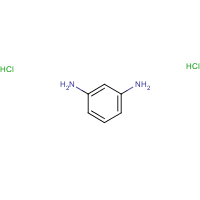1,3-Benzenediamine dihydrochloride
Agent Name
1,3-Benzenediamine dihydrochloride
CAS Number
541-69-5
Formula
C6-H8-N2.2Cl-H
Major Category
Nitrogen Compounds

Synonyms
1,3-Benzenediamine hydrochloride; 1,3-Diaminobenzene dihydrochloride; 1,3-Phenylenediamine dihydrochloride; 3-Aminoaniline dihydrochloride; m-Aminoaniline dihydrochloride; m-Benzenediamine dihydrochloride; m-Diaminobenzene dihydrochloride; m-Phenylenediamine hydrochloride; m-Phenylenediamine, dihydrochloride; meta-Aminoaniline dihydrochloride; meta-Benzenediamine dihydrochloride; meta-Diaminobenzene dihydrochloride; [ChemIDplus] UN1673
Category
Amines, Aromatic
Description
Off-white powder; [MSDSonline]
Sources/Uses
Used in hair dyes and as an analytical reagent for nitrite; No known commercial production in the US currently or in the past; [HSDB]
Comments
Has the potential to form methemoglobin; Emergency treatment: "Paraphenylenediamine"; In sensitized individuals, paraphenylenediamine may cause allergic contact dermatitis following application as a hair dye and asthma following inhalation; Following ingestion, can cause angioneurotic edema, methemoglobinemia, acute tubular necrosis, and hepatotoxicity; An adult died after ingestion of 3 grams of p-phenylenediamine; Another adult who ingested 1800 mg developed angioneurotic edema and acute renal failure; [HSDB] An eye irritant; May cause skin sensitization; [eChemPortal: ESIS] An irritant; Can be absorbed through skin; May cause skin sensitization; [MSDSonline] See "p-Phenylenediamine."
Biomedical References
Exposure Assessment
Explanatory Notes
The Guide in the Emergency Response Guidebook is for "Phenylenediamines."
Adverse Effects
Skin Sensitizer
Yes
Methemoglobinemia
MetHgb is secondary toxic effect
Hepatotoxin
Hepatoxic (a) from occupational exposure (secondary effect) or (b) in animal studies or in humans after ingestion
IARC Carcinogen
Not classifiable
Diseases, Processes, and Activities Linked to This Agent
Diseases
Occupational diseases associated with exposure to this agent:
Processes
Industrial Processes with risk of exposure: